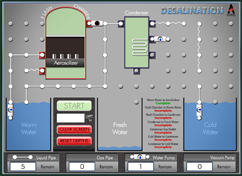Desalination

"Water, water, everywhere, nor any drop to drink." This line from the famous poem, The Rime of the Ancient Mariner, describes the condition many have faced when surrounded by seawater and in dire need of a drink of water. Ocean water is about three times saltier than a human’s blood and therefore, cannot be used as a thirst quencher. People have invented a number of techniques for purifying ocean water. Do you think it’s economically possible to change ocean water into fresh drinking water? Take a splash into this lesson and find out.
How does fresh water differ from ocean water?
Ocean water contains about 3.5% table salt (NaCl), while fresh water has a much lower concentration of salt (about 0.05%). Since the human body has a salt concentration of about 0.9%, drinking ocean water actually dehydrates or removes water from the cells of the body. Human body cells require water to complete a number of different cellular processes. Drinking fresh water provides these cells with water to carry out the necessary functions of the cell.What percentage of the water on Earth is fresh water?
Over 75% of planet Earth is covered by water. However, about 97.5% of all of the water on Earth is ocean water, or water with a salt concentration of about 3.5%. In fact, only around 2.5% of Earth's water is fresh water for direct human consumption. While ocean water is highly abundant, fresh drinking water sources are much scarcer than sea water.What percentage of Earth's fresh water is readily available in lakes, river, and streams?
Most of Earth's fresh water is not readily available for human consumption. About 70% of this water is locked up in ice caps and would have to first be melted before yielding drinking water. Other fresh water is in the atmosphere or deep within the earth in locations not reachable with current technologies. Only 1.3% of fresh water is located in regions where relatively easy access to the water is available.What are some common methods for purifying ocean water?
Although currently costly, ocean water can be purified or desalinated for human drinking. A number of process can remove the salt from ocean water, including ion exchanges, reverse osmosis, and boiling or freezing the ocean water. Some have even suggested that icebergs could be lassoed, towed to dry regions, and melted to supply drinking water. A more practical solution is to use small temperature gradients between different depths of ocean water to power a desalination plant. All of these methods have limitations and generally are much more expensive than using existing fresh water supplies.Walkthrough
Tier 2 Lessons: Grades 7 - 12+
Tier 1 Lessons: Grades 3 - 6
You need to log in to access this simulation.



